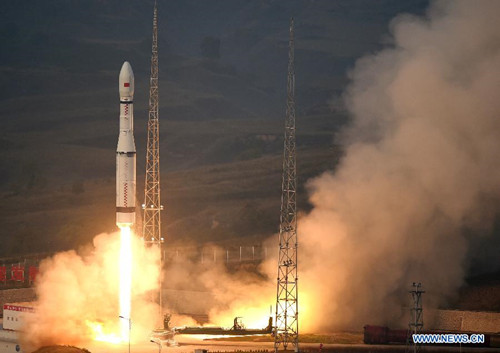
Long March-6 smaller, less toxic
China on Sunday launched a new model carrier rocket, the Long March-6, in North China's Shanxi Province, carrying a record-high 20 micro-satellites for space tests.
The white rocket, emblazoned with the Chinese flag, climbed into the bluish-grey skies overhead the Taiyuan Satellite Launch Center at 7:00 am on Sunday, according to footage aired by China Central Television (CCTV).
Designed by the China Aerospace Science and Technology Corporation (CASTC), developer of the Shenzhou VII spacecraft, the rocket is 29.3 meters high, shorter than rockets actively used in China's space program, media reports said.
The smaller rocket will make China more competitive in the market for commercial satellite launches, explained a Chinese official.
The new rocket, fueled by a liquid propellant made of liquid oxygen and kerosene, is China's first carrier rocket that uses fuel free of toxicity and pollution, said Gao Xinhui, an official at CASTC.
"Using this kind of propellant can cut costs by a great margin," Gao said.
Zhang Weidong, chief designer at the Shanghai Academy of Spaceflight Technology with CASTC, said the new rocket "changed the way carrier rockets are tested and launched in China."
"Loading, testing and positioning were finished when the Long March-6 rocket was in a horizontal position, before it was lifted to an upright position for launching," he said.
"We believe it will greatly boost the competitiveness of Chinese carrier rockets in the international market. The new model will also significantly improve our ability to access space," Zhang said.
Sunday's launch tested the feasibility and accuracy of the rocket's design as well as other new technologies.
China launches its own satellites as it continues to build a homegrown navigation system, but also carries out launches for other countries and commercial companies.
The new carrier rocket will be mainly used for the launch of micro-satellites.
"The separation control for the 20 satellites required high accuracy, precision and reliability," Hao Yaofeng, a technician at the Taiyuan Satellite Launch Center, told CCTV.
The satellites were developed by prestigious universities in China including Zhejiang University, Tsinghua University and other research institutes.
They will be used for experiments in technology and new products, CCTV said.
A 2011 policy paper issued by the State Council said the Long March-6 would be capable of placing a ton of payload into orbit at a height of 700 kilometers.
China outlined its five-year space mission in 2011. Among the items outlined are the launch of manned spaceships, next-generation rockets and the use of cleaner fuel, all of which are expected to help the country realize its goal of building a space station by 2020.


















































